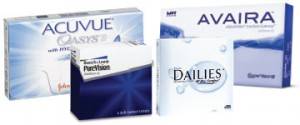
About Age-related Eye Diseases
At Loudoun Eye Associates in Ashburn, VA, medical eye care services and ocular disease management are among our specialties. With over 15 years of experience as expert optometrists, Dr. Richard Kao or Dr. Roy Park will examine your eyes thoroughly to diagnose, treat, and manage your eye disease(s). Whether you have diabetic retinopathy, hypertensive retinopathy, glaucoma, cataracts, or macular degeneration, we’re here to help keep your visual system healthy and your eyesight as sharp as possible!
Overview
After age 40, it’s typical for you to experience changes in your vision, and you’re at an increased risk of developing many common eye diseases. To help you understand these diseases better, we’ve put together the following basic explanations:
Diabetic Retinopathy
A complication associated with diabetes, diabetic retinopathy is a leading cause of blindness and severe vision loss. This disease is diagnosed when tiny blood vessels inside the retina are damaged; they may become swollen and leak fluid. Sometimes abnormal blood vessels develop on the surface of the retina and bleed into the eye, which will cause dark or black spots that block vision.
There are generally no symptoms or warning signs during the early and moderate stages of this disease. Yet as the disease worsens, pain or blurred vision may occur when the macula (central part of the retina) becomes inflamed. Since the disease can progress very far without symptoms, annual comprehensive dilated eye exams are recommended for everyone with diabetes.
Hypertensive Retinopathy
When you suffer from prolonged high blood pressure, the walls of your retinal blood vessels may thicken, which narrows the vessels so that less blood flow can reach the retina. With time, hypertension will thereby restrict and damage the healthy functioning of your retina. Abnormal pressure may also be placed on your optic nerve, which leads to visual problems. Altogether, this condition is referred to as Hypertensive Retinopathy (HR).
There are generally no symptoms of HR until the disease is at an advanced stage. Then, possible signs include swollen eyes, bursting blood vessels, reduced vision, headaches and double vision. If you have hypertension and notice sudden changes in your vision, you should seek immediate medical assistance.
Glaucoma
Increased pressure in your inner eye is the primary characteristic of glaucoma. Your eyeball requires adequate internal fluid pressure to maintain its spherical shape and capability of sight. With glaucoma, the eye fails to preserve the proper balance between the fluid produced inside the eye and the fluid that drains out. As a result, eye pressure climbs to dangerously high levels and compromises healthy vision.
Over time, the optic nerve is damaged and the eye cannot transmit visual images accurately to the brain. As the disease progresses, vision loss or complete blindness results. Glaucoma is the second-leading cause of blindness among Americans above the age of 40, and unfortunately, the damage is irreversible. The strongest risk factors for glaucoma include diabetes, age above 60, family history of the disease and being a member of the Mexican American population.
Glaucoma is usually silent at the beginning and only detected when the optic nerve has already been harmed. It’s important to note there are some forms of the disease that cause sudden symptoms of blurred sight, intense pain, nausea or vomiting, and halos around lights. If these symptoms occur, you’re advised to go to the emergency room or contact your eye doctor immediately to prevent vision loss.
Macular Degeneration
The most common type of macular problem is age-related macular degeneration (AMD). This refers to a breakdown of your macula, which is a small part of the retina that’s responsible for your central vision. The macula is what enables you to see fine details, such as small print or needlework. Macular degeneration can cause blurred vision, distortion of sight in your central vision, and may lead to permanent vision loss. Peripheral vision is generally not affected – so you may be able to see the outline of a flower’s petals, but not the center of the blossom. There are two types: dry macular degeneration (non-neovascular) and wet macular degeneration (neovascular).
Dry macular degeneration is the most common form of the disease, taking account for the vast majority of all cases. Dry AMD may be caused by pigment deposits in the macula or the thinning and aging of macular tissues – or a combination of these two problems. Yellowish spots, called drusen, accumulate in the macula and affect central vision.
Wet AMD is a more advanced stage and more harmful. New blood vessels develop and spread beneath the retina, and they begin to leak fluid and blood. The leaking permanently damages light-sensitive cells in your retina, which leads to a blind spots or a complete loss of vision in the center of your eye.
Macular degeneration typically progresses slowly and painlessly. At the early stages, you may notice shadowy, fuzzy or distorted regions in your central vision. Don’t ignore these warning signs, schedule an appointment with your eye doctor immediately! A comprehensive retinal eye exam by a qualified medical professional is the only way to detect AMD before the symptoms worsen.
Cataracts
A cataract is described as a clouding of the lens of your eye. Whenever you see something, what happens is that light rays enter your eye through the pupil, and then they are focused onto the retina through the lens of your eye. In order to focus light properly onto the retina, the lens must be crystal-clear. If you notice that your vision changes and becomes cloudy, blurry or dim (colors aren’t as bright), a cataract may be to blame. Only a complete, dilated eye evaluation by your eye doctor can diagnose cataracts.
The lens of your eye is composed primarily of protein and water. The protein is constructed so that the lens stays clear and permits the passage of light. As you age, some of these proteins may clump and thereby disturb vision in a small area of the lens. This clump is a cataract, and with time it may get larger and cover even more of your lens. Most cataract problems seem to occur after age 55, however there are other risk factors, such as diabetes or use of steroid medications.
Management & Treatment for Ocular Diseases
Managing these common eye diseases all depends upon regular follow-up appointments with your eye doctor. Dr. Lee Ford, and the entire compassionate team at Golden Triangle Eye Clinic, is highly skilled and experienced in ocular disease management. Our office in Columbus, MS, is furnished with top diagnostic equipment, and we are committed to staying current with medical advances in eye care. If you have an eye disease, we invite you to benefit from our advanced treatments and specialized eye care services.
The medical treatment and approach varies for each specific condition. Read on for a basic rundown of the management and treatment options for common eye diseases.
Diabetic Retinopathy
Diabetic retinopathy can be treated before vision loss occurs. Laser surgery is often advised, and it can decrease the risk of total vision loss by up to 90%. Unfortunately, laser surgery cannot always restore vision after it is lost – which underscores the need for regular comprehensive eye exams to detect signs of retinopathy before they cause irreversible damage. Other treatment options include performing a vitrectomy, which replaces the inner gel inside the eye.
Managing retinopathy involves achieving better blood glucose control. Controlling diabetes with proper blood sugar levels greatly delays the onset and slows the progression of diabetic retinopathy.
Hypertensive Retinopathy
Medical management for HR involves controlling high blood pressure. A combination of lifestyle changes and various medications may be prescribed. If your hypertension is severe and eye damage has already been caused, some of the vision loss may be permanent.
Glaucoma
There are a variety of treatment methods for glaucoma, including medications, laser surgery or conventional surgery. Medicated eye drops to control glaucoma are generally the first course of action tried. Carelessness and non-compliance with taking these eye drops is one of the most common reasons for blindness as a result from glaucoma.
Glaucoma surgeries work to reduce the natural production of inner eye fluid and/or to increase the drainage of this fluid. By doing this, the inner eye pressure is lowered and stabilized, and damage to the optic nerve may be prevented.
Macular Degeneration
While there are treatments to delay the progression of macular degeneration, there is currently no true cure for the disease. Nutritional supplements, such as antioxidant vitamins and zinc, may help slow the deterioration of dry AMD.
With wet AMD, a few drugs are FDA-approved for stopping the growth of abnormal blood vessels – which helps to prevent vision loss. Thermal laser procedures, performed on an outpatient basis, are another treatment that may be used to maintain vision. Alternatively, photodynamic therapy (PDT) may be recommended. This medical approach uses a combination of a photosensitizer (a light-activated drug) and a special “cool” laser, and it aims to treat macular degeneration directly in the center of the macula.
Once vision has been reduced due to macular degeneration, a variety of low vision devices are available to maximize your remaining vision for an improved quality of life.
Cataracts
Cataracts cannot be reversed with medication or eye drops, but they are highly treatable with specialized surgery. Frequently, cataracts will be left in place as long as they aren’t significantly affecting vision. A new eyeglass prescription may even do the trick for a while. Yet constant monitoring of cataracts by your eye doctor is necessary.
Once vision problems bother your daily life, surgery to remove the cataract will likely be advised. Cataract surgery removes your eye’s cloudy lens and replaces it with a clear plastic lens implant. This quick procedure is generally done as an outpatient surgery, with no need for a hospital stay. It is actually the most common surgical procedure done in the U.S., and more than 90% of the cases show restored good vision; complications that threaten sight are rare.
- Cataracts are a common cause of vision loss after age 55. Learn more about recognizing cataracts symptoms, protecting your eyes and understanding cataract surgery.
- There’s no separating diabetes and vision. If you have diabetes, then you should understand vision problems that increase in likelihood as a result of the disease.
- Glaucoma testing involves measuring internal eye pressure and a detailed scan of the retina for signs of disease.
- Macular degeneration is an eye disease that affects the portion of the eye responsible for processing fine detail and providing sharp central vision (called the macula).


